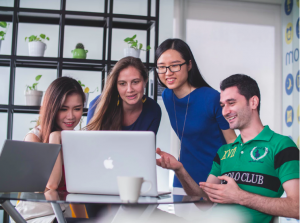
Image Source: Unsplash
Traditional learning has long been a teacher-centered, one-way process. In a classroom, the chairs are fixed in rows, wherein students face the teacher and absorb the information given to them. There are interactive activities, such as group work and peer discussions; however, the teacher still has the main responsibility of providing knowledge. Moreover, the materials in such an educational setting were limited to textbooks and printed materials. These were not only expensive, but their distribution and use were limited to those who had access to them.
This has changed with the rise of the internet and other technological learning tools. Learning is no longer a one-way process with the teacher in the center, but one that is increasingly inclusive and interactive. Students, especially young people, no longer need to sit in a classroom with four walls in order to learn. Instead, they can access the internet and explore a whole new world of endless information and knowledge. This has been taken further by the concept of Open Education Resources, or OER. According to Bronwyn Hegarty, a lecturer in tertiary education in Otago Polytechnic, Open Education Resources and Practices have changed the process of learning and teaching entirely. Moreover, according to her, such resources and practices are ways in which the creation and use of educational tools innovate and improve the quality of education. This is a departure from a more traditional approach to education, and follow a trajectory of a more dynamic and open learning process, both for the educator and the student.
One of the main elements of Open Education Resources is participation. This is a practice in which both the educator and the student are involved in the learning process. As mentioned earlier, this is not the traditional approach to education. Open Education Resources and Practices promote participation in numerous ways. First, the medium or platform on which such resources are found are available to all through the web. This means that a student who may not have access to the physical copy of a book in the school library may instead acquire an electronic copy. Access to educational material is increased and made available to all, simply because of the nature of the web. Moreover, access is not limited to those who are enrolled in a university or who can pay for a library membership. Instead, no matter where you are in the world, you are able to learn from electronic resources. Second, the dynamics of learning has also been changed. Instead of learning from one individual, students are able to engage in peer-to-peer learning. Opinions, which are definitely varied due to the different backgrounds students come from, are shared and discussed. These discussions will definitely be more insightful that one taking place in a physical classroom. Students can then build on different electronic resources, leading to even more fruitful insights. Of course, there is a danger in this, as most opinions may go unchecked. After all, there is no teacher to monitor the thoughts and opinions of learners, and check if they are still in logical. This, I think, is the downside of unlimited learning freedom.
Open Education Resources are changing the way we learn and teach. It comes with much benefit, but also some danger in the form on unchecked knowledge. However, when knowledge is made more accessible to everyone in the world, then it definitely has more benefits than harm.
Source:
Hegarty, Bronwyn. “Attributes of Open Pedagogy: A Model for Using Open Educational Resources.” Educational Technology, Volume 55, 4, 2015, pages 3 – 13.
